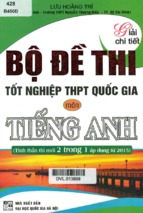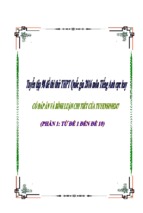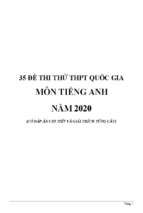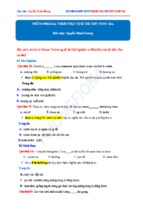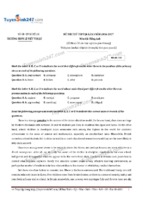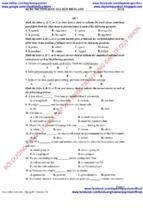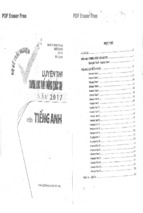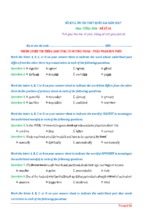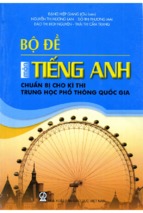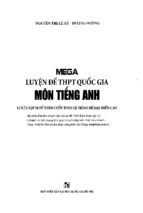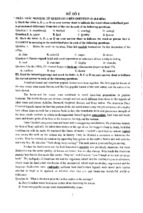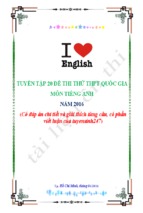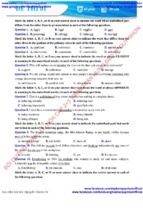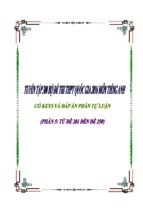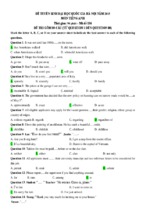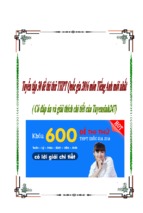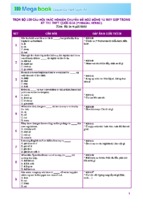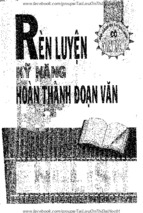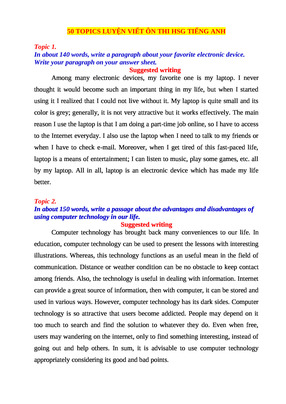ĐỀ SỐ 10
ĐỀ THI THỬ THPT QG NĂM HỌC 2020
Môn: Tiếng anh
Thời gian làm bài: 60 phút, không kể thời gian phát đề
Mark the letter A, B, C, or D on your answer sheet to indicate the word whose underlined part
differs from the other three in pronunciation in each of the following questions.
Question 1.
A. chin
B. chaos
C. child
D. charge
Question 2.
A. mood
B. flood
C. spoon
D. moon
Mark the letter A, B, C, or D on your answer sheet to indicate the word that differs from the
other three in the position of primary stress in each of the following questions.
Question 3.
A. category
B. accompany
C. experience
D. compulsory
Question 4.
A. tradition
B. modernize
C. impressive
D. emotion
Mark the letter A, B, C, or D on your answer sheet to indicate the correct answer to each of the
following questions.
Question 5. ___________ giraffe is the tallest of all ___________ animals.
A. A/ the
B. The/ Ø
C. A/ Ø
D. Ø/ the
Question 6. Unlike most birds, ___________.
A. the heads and necks of vultures lack feathers
B. vultures do not have feathers on their heads and necks
C. feathers are not found on the heads and necks of vultures
D. there are no feathers on vultures’ heads and necks.
Question 7. Some men are concerned with physical ___________ when they choose a wife.
A. attract
B. attractive
C. attractiveness
D. attractively
Question 8. A number of students ___________ for a rise since last year.
A. ask
B. have asked
C. has asked
D. asked
Question 9. ___________ at by everyone, he was disappointed.
A. Laughed
B. Laugh
C. Laughing
D. In laugh
Question 10. The teacher recommended that Linda ___________ her essay as soon as possible.
A. finish writing
B. finished writing
C. should finish to write
D. finishes writing
Question 11. I won’t change my mind ___________ what you say.
A. whether
B. no matter
C. because
D. although
Question 12. The organization underwent ___________ reforms.
A. far-reaching
B. far-gone
C. far-off
D. far-flung
Question 13. I didn’t ___________ to see my aunt when I was in Paris.
Trang 1
A. take
B. make
C. get
D. meet
Question 14. Vietnam’s rice export this year will decrease __________ about 10%, compared
with that of last year.
A. with
B. at
C. by
D. on
Question 15. She built a high wall round her garden __________ .
A. in order that her fruit not be stolen
B. to enable people not taking her fruit
C. so that her fruit would be stolen
D. to prevent her fruit from being stolen
Question 16. The Beauty Contest is __________ start at 8:00 a.m our time next Monday.
A. due to
B. bound to
C. about to
D. on the point of
Question 17. By the end of the 21 st century, scientists __________ a cure for the common cold.
A. will find
B. will have found
C. will be finding
D. will have been found
Question 18. There is one person to __________ I owe more than I can say.
A. whom
B. who
C. that
D. whose
Mark the letter A, B, C, or D on your answer sheet to indicate the word(s) CLOSEST in meaning
to the underlined word(s) in each of the following questions.
Question 19. The new cartoon film catches the fancy of the children.
A. satisfies
B. amuses
C. attracts
D. surprises
Question 20. The teacher gave some suggestions on what could come out for the examination.
A. effects
B. symptoms
C. hints
D. demonstrations
Mark the letter A, B, C, or D on your answer sheet to indicate the word(s) OPPOSITE in
meaning to the underlined word(s) in each of the following questions.
Question 21. Fruit and vegetables grew in abundance on the island. The islanders even exported
the surplus.
A. excess
B. large quantity
C. small quantity
D. sufficiency
Question 22. There are several different kinds of faults in reading which are usually more
exaggerated with foreign learners.
A. overestimated
B. understated
C. overemphasized
D. undertaken
Mark the letter A, B, C, or D on your answer sheet to indicate the option that best completes each
of the following exchanges.
Question 23. David and Tom are meeting after a long time.
- David: “How have you been recently?”
- Tom: “_________________.”
A. I am going on holiday next week.
B. By bus, usually.
C. I am working here.
D. Pretty busy, I think.
Question 24. - “Well, cats are very good at catching mice around the house.”
Trang 2
- “_________________.”
A. Nothing more to say
B. You can say that again
C. Yes, I hope so
D. No, dogs are very good, too
Read the following passage and mark the letter A, B, C, or D on your answer sheet to indicate
the correct word or phrase that best fits each of the numbered blanks from 25 to 29.
Beatrix Potter was a story writer whose books about animals have been translated into many
languages and read by both children and adults. (25) __________ being an author, she was also
regarded as a very successful farmer. Bom in London in 1866, Beatrix was (26) __________ for
at home by various servants. Every year she (27) __________ the days to her annual holiday in
the countryside. She would take to her London home small animals which she (28) __________
and drew. As she grew up, she entertained other children with drawings and stories about these
animals. In 1901, she printed a book at her own (29) __________ called ‘The Tale of Peter
Rabbit’. So many copies were sold that she bought a farm, where over the next eight years she
wrote many other stories. They all sold very well and readers
liked their detailed color drawings.
Question 25.
A. Apart
B. Besides
C. Otherwise
D. Except
Question 26.
A. cared
B. minded
C. attended
D. looked
Question 27.
A. imagined
B. counted
C. considered
D. numbered
Question 28.
A. remarked
B. noticed
C. saw
D. observed
Question 29.
A. earning
B. spending
C. expense
D. charge
Read the following passage and mark the letter A, B, C, or D on your answer sheet to indicate
the correct answer to each of the questions from 30 to 34.
Foot-racing is a popular activity in the United States. It is seen not only as a competitive sport
but also as a way to exercise, to enjoy the camaraderie of like-minded people, and to donate
money to a good cause.
Though serious runners may spend months training to compete, other runners and walkers might
not train at all. Those not competing to win might run in an effort to beat their own time or
simply to enjoy the fun and exercise. People of all ages, from those of less than one year (who
may be pushed in strollers) to those in their eighties, enter into this sport. The races are held on
city streets, on college campuses, through parks, and in suburban areas, and they are commonly 5
to 10 kilometers in length.
The largest footrace in the world is the 12-kilometer Bay to Breakers race that is held in San
Francisco every spring. This race begins on the east side of the city near San Francisco Bay and
ends on the west side at the Pacific Ocean. There may be 80,000 or more people running in this
race through the streets and hills of San Francisco. In the front are the serious runners who
compete to win and who might finish in as little as 34 minutes. Behind them are the thousands
Trang 3
who take several hours to finish. In the back of the race are those who dress in costumes and
come just for fun. One year there was a group of men who dressed like Elvis Presley, and
another group consisted of firefighters who were tied together in a long line and who were
carrying a fire-hose.
There was even a bridal party, in which the bride was dressed in a long white gown and the
groom wore a tuxedo. The bride and groom threw flowers to bystanders, and they were actually
married at some point along the route.
Question 30. The word “camaraderie” as used in the first paragraph could be best replaced by
which of the following?
A. games
B. companionship
C. jokes
D. views
Question 31. Which of the following is NOT implied by the author?
A. Footraces appeal to a variety of people.
B. Walkers can compete for prizes.
C. Entering a race is a way to give support to an organization.
D. Running is a good way to strengthen the heart.
Question 32. The word “beat” as used in the first paragraph could be best replaced by which of
the following?
A. incline
B. overturn
C. outdo
D. undermine
Question 33. In what lines does the author give reasons for why people enter footraces?
A. Foot-racing ... and exercise.
B. People of all ages ... in length.
C. The largest... 34 minutes.
D. Behind them ... a fire-hose.
Question 34. Which of the following is NOT mentioned in this passage?
A. Some runners looked like Elvis Presley.
B. Some runners were ready to put out a fire.
C. Some runners were participating in a wedding.
D. Some runners were serious about
winning.
Read the following passage and mark the letter A, B, C, or D on your answer sheet to indicate
the correct answer to each of the questions from 35 to 42.
Most desert animals will drink water if confronted with it, but many of them never have any
opportunity. All living things must have water, or they will expire. The herbivores find it in
desert plants. The carnivores slake their thirst with the flesh and blood of living prey. One of the
most remarkable adjustments, however, has been made by the tiny kangaroo rat, who not only
lives without drinking but subsists on a diet of dry seeds containing about 5% free water. Like
other animals, he has the ability to manufacture water in his body by a metabolic conversion of
carbohydrates. But he is notable for the parsimony with which he conserves his small supply by
every possible means, expending only minuscule amounts in his excreta and through evaporation
from his respiratory tract.
Trang 4
Investigation into how the kangaroo rat can live without drinking water has involved various
experiments with these small animals. Could kangaroo rats somehow store water in their bodies
and slowly utilize these resources in the long periods when no free water is available from dew
or rain? The simplest way to settle this question was to determine the total water content in the
animals to see if it decreases as they are kept for long periods on a dry diet. If they slowly use up
their water, the body should become increasingly dehydrated, and if they begin with a store of
water, this should be evident from an initial high water content. Results of such experiments with
kangaroo rats on dry diets for more than 7 weeks showed that the rats maintained their body
weight. There was no trend toward a decrease in water content during the long period of water
deprivation. When the kangaroo rats were given free access to water, they did not drink water.
They did nibble on small pieces of watermelon, but this did not change appreciably the water
content in their bodies, which remained at 66.3% to 67.2% during this period.
This is very close to the water content of dry-fed animals (66.5%), and the availability of free
water, therefore, did not lead to any “storage” that could be meaningful as a water reserve. This
makes it reasonable to conclude that physiological storage of water is not a factor in the
kangaroo rat’s ability to live on dry food.
Question 35. What is the topic of this passage?
A. Kangaroo rats
B. Water in the desert
C. Desert life
D. Physiological experiments
Question 36. The word “expire” in paragraph 2 is closest in meaning to ___________.
A. become ill
B. die
C. shrink
D. dehydrate
Question 37. Which of the following is NOT a source of water for the desert animals?
A. desert plants
B. metabolic conversion of carbohydrates in the body
C. the blood of other animals
D. streams
Question 38. The author states that the kangaroo rat is known for all of the following EXCEPT
__________
A. the economy with which it uses available water
B. living without drinking water
C. breathing slowly and infrequently
D. manufacturing water internally
Question 39. The word “parsimony” in paragraph 1 is closest in meaning to _____________.
A. intelligence
B. desire
C. frugality
D. skill
Question 40. It is implied by the author that desert animals can exist with little or no water
because of ________________.
A. less need for water than other animals
B. many opportunities for them to find water
C. their ability to eat plants
D. their ability to adjust to the desert environment
Trang 5
Question 41. The word “deprivation” in paragraph 2 is closest in meaning to ____________.
A. preservation
B. renewal
C. examination
D. loss
Question 42. According to the passage, the results of the experiments with kangaroo rats showed
that
A. kangaroo rats store water for use during dry periods
B. kangaroo rats took advantage of free access to water
C. there was no significant change in body weight due to lack of water or accessibility to water
D. a dry diet seems detrimental to the kangaroo rat’s health
Mark the letter A, B, C, or D on your answer sheet to indicate the underlined part that needs
correction in each of the following questions.
Question 43. Those people say (A) that it is (B) such polluted air that they (C) can’t breath, (D)
don’t they?
Question 44. His father (A) asked him (B) what (C) did he want (D) for his birthday.
Question 45. Helen Killer, (A) who was both (B) blind and (C) deafness, overcame her (D)
inabilities
with the help of her teacher, Ann Sulivan.
Mark the letter A, B, C, or D on your answer sheet to indicate the sentence that is closest in
meaning to each of the following questions.
Question 46. Due to the fact that the demand for tea was very high in the 19 th century, its price
was astronomical.
A. It was not until the 19 th century that the demand for tea started to increase.
B. The demand for tea was so high in the 19th century that its price was enormous
C. In the 19 th century the price for tea didn’t increase despite the demand.
D. In the 19 th century, even though the demand for tea was enormous its price remained cheap.
Question 47. The situation was so embarrassing that she did not know what to do.
A. So embarrassing was the situation that she did not know what to do.
B. It was such an embarrassing situation; however, she did not know what to do.
C. So embarrassing the situation was that she did not know what to do.
D. She did not know what to do, though it was not an embarrassing situation.
Question 48. Impressed as we were by the new cinema, we found it rather expensive.
A. We weren’t as much impressed by the new cinema’s look as its cost.
B. The new cinema was more expensive than we expected.
C. We were very impressed by the new cinema, but found it rather expensive.
D. We were not impressed by the new cinema at all because it looked rather expensive.
Mark the letter A, B, C, or D on your answer sheet to indicate the sentence that best combines
each pair of sentences in the following questions.
Trang 6
Question 49. You cannot completely avoid stress in your life. You need to find ways to cope
with it.
A. After you can completely avoid stress in your life, you need to find ways to cope with it.
B. As long as you can completely avoid stress in your lives, you need to find ways to cope with
it.
C. As you cannot completely avoid stress in your life, you need to find ways to cope with it.
D. Because stress can completely be avoided in your life, you need to find ways to cope with it.
Question 50. The student next to me kept chewing gum. That bothered me a lot.
A. The student next to me kept chewing gum, which bothered me a lot.
B. The student next to me kept chewing gum, that bothered me a lot.
C. The student next to me kept chewing gum bothering me a lot.
D. The student next to me kept chewing gum bothered me a lot.
Đáp án
1-B 2-B 3-A 4-B 5-B 6-B 7-C 8-B 9-A 10-A
11-B 12-A 13-C 14-C 15-D 16-B 17-B 18-A 19-C 20-C
21-C 22-B 23-D 24-B 25-B 26-A 27-B 28-D 29-C 30-B
31-D 32-C 33-A 34-B 35-A 36-B 37-D 38-C 39-C 40-D
41-D 42-C 43-C 44-C 45-C 46-B 47-A 48-C 49-C 50-A
LỜI GIẢI CHI TIẾT
Question 1: Đáp án B
- chin /tʃɪn/ (n): cằm
- chaos /ˈkeɪɒs/ (n): sự hỗn loạn, sự lộn xộn
- child /tʃaɪld/ (n): đứa trẻ
- charge /tʃɑːdʒ/ (n): giá tiền, phí; (v): tính giá, buộc tội
Question 2: Đáp án B
- mood /muːd/ (n): tâm trạng - flood /flʌd/ (n): lũ lụt
- spoon /spuːn/ (n): thìa - moon /muːn/ (n): mặt trăng
Question 3: Đáp án A
- category /ˈkætɪɡəri/ (n): hạng, loại
- accompany /əˈkʌmpəni/ (v): đi cùng; kèm theo; đệm (nhạc)
- experience /ɪkˈspɪərɪəns/ (n): kinh nghiệm, trải nghiệm (Những từ có tận cùng là -ience thì
trọng âm nhấn vào âm tiết ngay trước nó)
- compulsory /kəmˈpʌlsəri/ (adj): bắt buộc
Question 4: Đáp án B
- tradition /trəˈdɪʃn̩/ (n): truyền thống
- modernize /ˈmɒdənaɪz/ (v): hiện đại hóa
Trang 7
- impressive /ɪmˈpresɪv/ (adj): gây ấn tượng sâu sắc
- emotion /ɪˈməʊʃn/ (n): cảm xúc
Question 5: Đáp án B
Mạo từ “ the” + N số ít trong câu này dùng để chỉ cả giống loài đó
Dịch: Hươu cao cổ là loài cao nhất trong tất cả các loài động vật.
Question 6: Đáp án B
- Unlike + N (Không giống như) dùng để cho thấy 2 thứ khác nhau, phải tương đương về chủ thể
so sánh
Dịch: Không giống như hầu hết các loài chim, kền kền không có lông trên đầu và cổ
Question 7: Đáp án C
- attract (v): hấp dẫn, thu hút
- attractive (adj): hấp dẫn, quyến rũ → attractively (adv)
- attractiveness (n): sự thu hút, sự hấp dẫn, quyến rũ (về ngoại hình)
Dịch: Một số đàn ông quan tâm đến vẻ đẹp ngoại hình khi họ chọn vợ.
Question 8: Đáp án B
- Since + mốc thời gian → sử dụng thì hoàn thành
- A number of N số nhiều + V (chia số nhiều): Một số những → dùng “have”
Question 9: Đáp án A
Câu đầy đủ: Because/ As he was laughed at by everyone, he was disappointed.(chủ ngữ 2 vế
giống nhau; bị động)
→ Laughed at by everyone, he was disappointed, (rút gọn mệnh đề trạng ngữ)
Đây là dạng rút gọn của mệnh đề trạng ngữ.
Dịch: Bị mọi người cười nhạo, anh ấy rất thất vọng.
Question 10: Đáp án A
Cấu trúc:S + recommend + that + S + V (bare-inf)..................(thể giả định)
- finish + V-ing: hoàn thành làm gì đó
Dịch: Giáo viên khuyên Linda hoàn thành bài luận sớm nhất có thể.
Question 11: Đáp án B
- No matter what = Whatever: dù có gì ...đi chăng nữa
- Whether ...or: hoặc ... hoặc
- Because: bởi vì
- Although +: mặc dù
Dịch: Tôi sẽ không thay đổi quyết định dù bạn nói gì đi chăng nữa.
Question 12: Đáp án A
- far-reaching (adj): có ảnh hưởng sâu rộng, tác động lớn
- far-gone (adj): ốm rất nặng, say mềm
Trang 8
- far-off (adj): xa xôi, xa xưa
- far-flung (adj): xa, trải rộng bao la
Dịch: Tổ chức đã trải qua những cuộc cải cách lớn.
Question 13: Đáp án C
Cấu trúc: take to doing sth ~ begin/ start to do sth as a habit: bắt đầu làm gì như một thói quen
- get to do sth ~ have the opportunity to do sth: có cơ hội làm gì đó
Dịch: Tôi đã không có cơ hội gặp dì tôi khi tôi ở Paris.
Question 14: Đáp án C
- Decrease/Increase by + ...%: giảm/tăng ...%
Dịch: Xuất khẩu gạo của Việt Nam trong năm nay sẽ giảm khoảng 10%, so với cùng kỳ năm
ngoái.
Question 15: Đáp án D
- in order that/ so that + a clause: để mà (diễn tả mục đích)
A Sai ngữ pháp
B Sai ngữ pháp (enable somebody to do something)
C Cô ấy xây tường cao xung quanh vườn để hoa quả của cô ấy bị ăn trộm. (Sai về mặt logic
nghĩa)
D để ngăn cản việc hoa quả bị ăn trộm (prevent somebody from doing something: ngăn cản ai đó
làm việc gì)
Question 16: Đáp án B
- be due to V: mong đợi xảy ra (nói về 1 sự kiện/ sự việc mong đợi xảy ra tại thời điểm cụ thể
nào đó trong tương lai (có kèm thời gian))
- due to+ V-ing/ N ~ because of: bởi vì
- be bound to + V ~ certain or extremely likely to happen: chắc chắn xảy ra
- be about to + V ~ to be going to do something very soon: sắp sửa làm gì đó
- be on the point of + V-ing ~ to be going to do something very soon : sắp sửa làm gì đó
Dịch: Cuộc thi hoa hậu chắc chắn sẽ bắt đầu lúc 8 giờ 30 sáng thứ 2 tuần sau theo giờ của chúng
ta.
NOTE 23:
* Một số cụm từ diễn tả nghĩa tương tự như to be about to infinitive:
- be about to + bare Verb: sắp làm gì đó
- be on the verge of/ on the brink of/ on the point of + Ving/ N : đều diễn tả một điều gì đó hành
động nào đó sắp xảy ra (Tuy nhiên, cụm từ on the point of mang phong văn trang trọng hơn cả)
E.g: She is on the point of bursting into tears. (Cô ta sắp bật khóc.)
- be due to + infinitive: nói về 1 sự kiện/ sự việc mong đợi xảy ra tại thời điểm cụ thể nào đó
trong tương lai (có kèm thời gian)
Trang 9
E.g: The train is due to leave at 5a.m.
+ due to + N (do, vì): còn dùng để đưa ra lý do cho điều gì đó
E.g: Due to illness, Mary is unable to perform tonight. (Vì bị ốm nên Mary không thể biểu diễn
tối nay được.)
- be set to + infinitive: nói về những thứ sắp xảy ra theo dự kiến
E.g: Prices are set to rise once more.
- be bound/ sure/ certain to + infinitive: khẳng định điều gì đó chắc chắn sẽ xảy ra trong tương lai
E.g: The president is certain to resign. (Chủ tịch chắc chắn sẽ từ chức.)
Question 17: Đáp án B
Cấu trúc thì tương lai hoàn thành: will + have + PP
Dịch: Cho đến thời điểm cuối thế kỉ 21 thì các nhà khoa học sẽ tìm ra cách chữa trị cho bệnh cảm
lạnh.
Question 18: Đáp án A
- Who: đại từ quan hệ chỉ người, đứng sau danh từ chỉ người, làm chủ ngữ/ tân ngữ trong
MĐQH.
- Whom: đại từ quan hệ chỉ người, đứng sau danh từ chỉ người, làm tân ngữ trong MĐQH.
- That: đại từ quan hệ chỉ cả người lẫn vật, có thể được dùng thay cho who, whom, which trong
mệnh đề quan hệ xác định
- Whose: đại từ quan hệ chỉ sở hữu, đứng sau danh từ chỉ người hoặc vật, thay cho tính từ sở hữu
trước danh từ, luôn đi kèm với một danh từ.
Question 19: Đáp án C
catch/ take the fancy of.../ one’s fancy ~ attract/ please
someone: thu hút, làm ai thích thú
- satisfy (v): làm hài lòng - amuse (v): làm buồn cười, giải trí
- attract (v): thu hút, hấp dẫn - surprise (v): làm ngạc nhiên
Do đó: catch the fancy of ~ attract
Dịch: Bộ phim hoạt hình mới thu hút bọn trẻ.
Question 20: Đáp án C
- suggestion (n): lời gợi ý (= hint)
- effect (n): ảnh hưởng, tác động
- symptom (n): triệu chứng
- demonstration (n): sự thể hiện, trình bày, sự chứng minh
Dịch: Giáo viên đã đưa ra những gợi ý cho những vấn đề có thể xuất hiện trong kỳ thi.
Question 21: Đáp án C
- abundance (n) ~ large quantity : sự nhiều, phong phú; số lượng lớn small quantity (số lượng
nhỏ)
Trang 10
- excess (n): số vượt quá, số dôi; sự quá mức, sự vượt
- sufficiency (n): sự đầy đủ; lượng đủ
Question 22: Đáp án B
- exaggerated (adj): cường điệu hóa, phóng đại
- overestimated (adj) : đánh giá quá cao
- understated (adj): nói giảm đi, nói bớt
- overemphasized (adj): quá nhấn mạnh
Dịch: Có một vài loại lỗi khác nhau trong việc đọc mà thường xuyên phóng đại hơn với người
nước ngoài.
Question 23: Đáp án D
David: “Cậu dạo này như thế nào?” - Tom: “______________”
A. Tuần sau tớ sẽ đi nghỉ mát.
B. Thường xuyên đi bằng xe buýt,
C. Tớ đang làm việc ở đây.
D. Tớ nghĩ là khá bận rộn.
Question 24: Đáp án B
- “Ô, những con mèo rất giỏi bắt chuột khắp nhà.” - “__________________”
A. Không có gì để nói hơn
B. Mình đồng ý với bạn
C. Vâng, mình hi vọng vậy
D. Không, những con chó cũng giỏi
Question 25: Đáp án B
- Besides ~ In addition to: ngoài.. .ra, thêm vào
- Otherwise: Nếu không thì
- Except: trừ ra, loại ra
- Apart from dùng với cả 2 nghĩa là besides và except
Lưu ý: Sau những từ như: no, nothing, nobody và những từ phủ định tương tự, besides, except và
apart from có cùng nghĩa với nhau.
“Besides being an author, she was also regarded as a very successful farmer.” (Ngoài là một tác
giả ra thì bà ấy cũng được xem như một người nông dân thành công.)
Question 26: Đáp án A
- care for ~ take care of: chăm sóc
Care for trang trọng hơn và trong văn học thường hay được ưa dùng
- mind ~ take care of: chăm sóc, trông non
- attend to sb (v): chăm lo, chăm sóc
- look for: tìm kiếm
“Born in London in 1866, Beatrix was cared for at home by various servants.” (Được sinh ra tại
Luân
Đôn vào năm 1866, Beatrix được rất nhiều người hầu chăm sóc ở nhà.)
Question 27: Đáp án B
Trang 11
- imagine (v): tưởng tượng - count (v): đếm
- consider (v): xem xét, cân nhắc - number (v): đánh số
“Every year she counted the days to her annual holiday in the countryside.” (Hằng năm, bà ấy
đều đếm số ngày tới kì nghỉ lễ ở quê của mình.”
Question 28: Đáp án D
- remark (v): nhận xét, phê bình - notice (v): chú ý, nhận biết
- see (v): nhìn thấy, gặp - observe (v) : quan sát
“She would take to her London home small animals which she observed and drew”. (Cô ấy bắt
đầu thích những con động vật bé nhỏ Luân Đôn mà cô ấy đã quan sát và vẽ.)
Question 29: Đáp án C
- at somebody’s expense: do ai đó trả tiền
“In 1901, she printed a book at her own expense called ‘The Tale of Peter Rabbit”. (Vào năm
1901, bà ấy đã in một cuốn sách do bà ấy trả tiền có tên là ‘Chuyện về chú thỏ Peter’)
Question 30: Đáp án B
Từ “camaraderie” được dùng trong đoạn đầu tiên có thể được thay thế tốt nhất bằng từ nào sau
đây?
A. trò chơi
B. tình bạn
C. chuyện đùa
D. quang cảnh/ quan điểm
Dẫn chứng: It is seen not only as a competitive sport but also as a way to exercise, to enjoy the
camaraderie of like-minded people, and to donate money to a good cause. (Nó không chỉ được
xem là một môn thể thao cạnh tranh mà còn là một cách để tập thể dục, để tận hưởng tình bạn
thân thiết của những người cùng mục đích chí hướng với nhau và để quyên góp tiền cho tổ chức
làm các việc tốt.)
Question 31: Đáp án D
Điều nào sau đây KHÔNG phải là ngụ ý của tác giả?
A. Cuộc thi chạy bộ hấp dẫn với nhiều người.
B. Những người chạy bộ có thể cạnh tranh để giành giải thưởng.
C. Tham gia cuộc đua là một cách để hỗ trợ một tổ chức.
D. Chạy là một cách tốt để giúp tim khỏe.
Dẫn chứng:
“It is seen not only as a competitive sport but also as a way to exercise, to enjoy the camaraderie
of likeminded people, and to donate money to a good cause.” (Nó không chỉ được xem là một môn thể
thao
Trang 12
cạnh tranh mà còn là một cách để tập thể dục, để tận hưởng tình bạn thân thiết của những người
cùng mục đích chí hướng với nhau và để quyên góp tiền cho tổ chức làm việc tốt như từ thiện.)
=> B, C đúng
“People of all ages, from those of less than one year (who may be pushed in strollers) to those in
their eighties, enter into this sport.” (Mọi người ở mọi lứa tuổi, từ những người em nhỏ dưới 1
tuổi (có thể nằm trong các xe đẩy) đến những người ở độ tuổi 80 đều tham gia môn thể thao này
=> A đúng
Question 32: Đáp án C
Từ “beat” trong đoạn đầu có thể được thay thế bởi từ nào sau đây?
A. cúi xuống, có khuynh hướng
B. đổ nhào, lật ngược
C. vượt hơn hẳn, đánh bại
D. làm hao mòn
Dẫn chứng: “Those not competing to win might run in an effort to beat their own time or simply
to enjoy the fun and exercise” (Những người không cạnh tranh để giành chiến thắng có thể nỗ
lực chạy để chiến thắng thời gian của chính mình hoặc đơn giản để tận hưởng niềm vui và tập thể
dục)
Question 33: Đáp án A
Tác giả đưa ra lý do tại sao con người nên tham gia chạy bộ trong những dòng nào?
Dẫn chứng: Foot-racing is a popular activity in the United States. It is seen not only as a
competitive sport but also as a way to exercise, to enjoy the camaraderie of like-minded people,
and to donate money to a good cause. Though serious runners may spend months training to
compete, other runners and walkers might not train at all. Those not competing to win might run
in an effort to beat their own time or simply to enjoy the fun and exercise. (Chạy bộ là hoạt động
phổ biến ở nước Mỹ. Nó không chỉ được xem là một
môn thể thao cạnh tranh mà còn là một cách để tập thể dục, để tận hưởng tình bạn thân thiết của
những người cùng mục đích chí hướng với nhau và để quyên góp tiền cho tổ chức làm việc tốt
như từ thiện. Mặc dù người chạy đua nghiêm túc có thể dành nhiều tháng tập luyện để thi đấu
giành giải nhưng những người khác không tập luyện chút nào cả. Những người không cạnh tranh
để giành chiến thắng có thể nỗ lực chạy để chiến thắng thời gian của chính mình hoặc đơn giản
để tận hưởng niềm vui và tập thể dục.)
Question 34: Đáp án B
Điều nào sau đây KHÔNG được đề cập trong bài đọc này?
A. Một số người chạy đua trông giống như Elvis Presley
B. Một số người chạy đua sẵn sàng dập lửa.
C. Một số người chạy đua tham dự đám cưới.
D. Một số người chạy đua nghiêm túc về việc chiến thắng.
Dẫn chứng:
Trang 13
- “One year there was a group of men who dressed like Elvis Presley” => A đúng
- There was even a bridal party, in which the bride was dressed in a long white gown and the
groom wore a tuxedo. => C đúng
- In the front are the serious runners who compete to win... => D đúng
Question 35: Đáp án A
Chủ đề của bài đọc là gì?
A. Loài chuột túi
B. Nước ở sa mạc
C. Đời sống sa mạc
D. Thí nghiệm sinh lý
Dẫn chứng:
- One of the most remarkable adjustments, however, has been made by the tiny kangaroo rat,
who not only lives without drinking but subsists on a diet of dry seeds containing about 5% free
water...
- Investigation into how the kangaroo rat can live without drinking water has involved various
experiments with these small animals...
Cả bài đọc này chủ yếu thảo luận về loài chuột túi
Question 36: Đáp án B
- become ill: trở nên ốm yếu - die: chết
- shrink: co lại, rút lại - dehydrate: hút nước, khử nước
Dẫn chứng: “Most desert animals will drink water if confronted with it, but many of them never
have any opportunity. All living things must have water, or they will expire”. (Hầu hết các loài
động vật trên sa mạc sẽ uống nước nếu gặp được nước, nhưng nhiều loài chưa bao giờ có cơ hội.
Tất cả các sinh vật sống phải có nước hoặc chúng sẽ chết.)
Do đó: expire ~ die
Question 37: Đáp án D
Cái nào sau đây KHÔNG phải là nguồn nước cho các động vật ở sa mạc?
A. thực vật sa mạc
B. quá trình trao đổi carbohydrates trong cơ thể
C. máu của động vật khác
D. suối
Dẫn chứng: The herbivores find it in desert plants. The carnivores slake their thirst with the flesh
and blood of living prey. One of the most remarkable adjustments, however, has been made by
the tiny kangaroo rat, who not only lives without drinking but subsists on a diet of dry seeds
containing about 5% free water. Like other animals, he has the ability to manufacture water in
his body by a metabolic conversion of carbohydrates.
Question 38: Đáp án C
Trang 14
Tác giả nói rằng chuột túi được biết đến với tất cả các đặc điểm sau NGOẠI
TRỪ_______________.
A. cách tiết kiệm nước có sẵn
B. sống mà không cần uống nước
C. thở chậm và không thường xuyên
D. tạo nước từ trong cơ thể
Dẫn chứng: One of the most remarkable adjustments, however, has been made by the tiny
kangaroo rat, who not only lives without drinking but subsists on a diet of dry seeds containing
about 5% free water. Like other animals, he has the ability to manufacture water in his body by a
metabolic conversion of carbohydrates. But he is notable for the parsimony with which he
conserves his small supply by every possible means, expending only minuscule amounts in his
excreta and through evaporation from his respiratory tract.
Question 39: Đáp án C
- intelligence (n): sự thông minh - desire (n): sự mong muốn, khát khao
- frugality (n): tính tiết kiệm - skill (n): kĩ năng
“But he is notable for the parsimony with which he conserves his small supply by every possible
means, expending only minuscule amounts in his excreta and through evaporation from his
respiratory tract.”
(Nhưng nó nổi tiếng với tính tiết kiệm qua việc bảo tồn nguồn cung cấp nhỏ bé của mình bằng
mọi cách có thể, chỉ dùng hết lượng rất nhỏ trong chất bài tiết và qua quá trình bay hơi từ đường
hô hấp)
Do đó: parsimony ~ frugality
Question 40: Đáp án D
Tác giả ngụ ý rằng động vật sa mạc có thể tồn tại với rất ít hoặc không cần nước bởi
vì___________.
A. ít có nhu cầu nước hơn các động vật khác
B. chúng có nhiều cơ hội tìm nước
C. khả năng ăn thực vật
D. khả năng thích nghi với môi trường sa mạc
Dẫn chứng: The herbivores find it in desert plants. The carnivores slake their thirst with the flesh
and blood of living prey. One of the most remarkable adjustments, however, has been made by
the tiny kangaroo rat, who not only lives without drinking but subsists on a diet of dry seeds
containing about 5% free water. Like other animals, he has the ability to manufacture water in
his body by a metabolic conversion of carbohydrates.
Question 41: Đáp án D
- preservation (n): sự bảo tồn, sự bảo quản
- renewal (n): sự làm mới, sự phục hồi
Trang 15
- examination (n): sự kiểm tra, sự nghiên cứu
- loss (n): sự mất
“There was no trend toward a decrease in water content during the long period of water
deprivation.”
(Không có xu hướng giảm lượng nước trong suốt thời kì dài mất nước.)
Question 42: Đáp án C
Theo bài đọc, kết quả của các thí nghiệm với chuột túi chỉ ra rằng ________________.
A. chuột túi dự trữ nước để sử dụng suốt thời kì khô hạn
B. chuột túi tận dụng việc tự do tiếp cận nguồn nước
C. không có sự thay đổi đáng kể về trọng lượng cơ thể do thiếu nước hay việc tiếp cận đến nguồn
nước
D. một chế độ ăn khô có vẻ có hại cho sức khỏe của chuột túi
Dẫn chứng: Results of such experiments with kangaroo rats on dry diets for more than 7 weeks
showed that the rats maintained their body weight. There was no trend toward a decrease in
water content during the long period of water deprivation. When the kangaroo rats were given
free access to water, they did not drink water. They did nibble on small pieces of watermelon,
but this did not change appreciably the water content in their bodies, which remained at 66.3 %
to 67.2 % during this period...”
Question 43: Đáp án C
- can’t + V(bare-inf)
- breath (n): hơi thở
- breathe (v): thở Do đó: breath => breathe
Question 44: Đáp án C
Cấu trúc: S + ask (ed) + (O) + từ để hỏi + S + V ....
Do đó: did he want => he wanted
Dịch: Bố cậu ấy hỏi cậu ấy muốn gì cho dịp sinh nhật.
Question 45: Đáp án C
- deafness (n): tật điếc - deaf (adj): điếc
Trong câu này, ta cần một tính từ chứ không phải là danh từ (to be + adj)
Question 46: Đáp án B
Câu ban đầu: Vì thực tế là nhu cầu uống trà rất lớn vào thế kỉ thứ 19 nên giá của nó cũng rất cao.
A. Mãi cho đến thế kỉ thứ 19 thì nhu cầu uống trà mới bắt đầu tăng.
B. Nhu cầu uống trà quá lớn vào thế kỉ 19 nên giá của nó cũng rất cao.
C. Vào thế kỉ 19
giá của trà không tăng dù có nhu cầu.
D. Vào thế kỉ 19, mặc dù nhu cầu uống trà lớn nhưng giá của nó vẫn rẻ.
Cấu trúc: S + be + so + adj + that + S + V .... (quá ....đến nỗi mà ...)
Trang 16
Question 47: Đáp án A
Câu ban đầu: Tình huống quá bối rối đến nỗi mà cô ấy không biết làm gì.
Cấu trúc:
- S + be + so + adj + that + mệnh đề = So + adj + be + S + that + S+ mệnh đề (quá.. .đến nỗi mà)
- S + be + such + (a/an) + adj + N + that + mệnh đề (quá ...đến nỗi mà)
Question 48: Đáp án C
Câu ban đầu: Mặc dù chúng tôi ấn tượng với rạp chiếu phim mới nhưng chúng tôi thấy rằng nó
hơi đắt đỏ.
Adj + as + S + be, mệnh đề (Mặc dù.. .nhưng...)
A, B, D sai nghĩa của câu
A. Chúng tôi đã không ấn tượng nhiều với vẻ ngoài của rạp chiếu phim mới vì nó có giá đắt.
B. Rạp chiếu phim mới thì đắt hơn chúng tôi mong đợi.
C. Chúng tôi rất ấn tượng với rạp chiếu phim mới, nhưng thấy nó hơi đắt.
D. Chúng tôi không ấn tượng với rạp chiếu phim mới chút nào vì nó trông hơi đắt.
Question 49: Đáp án C
“Bạn không thể hoàn toàn tránh được căng thẳng trong cuộc sống. Bạn cần tìm cách để đối phó
với nó.”
A. Sau khi bạn có thể hoàn toàn tránh được căng thẳng trong cuộc sống thì bạn cần tìm cách để
đối phó với nó.
B. Ngay khi bạn có thể hoàn toàn tránh được căng thẳng trong cuộc sống thì bạn cần tìm cách để
đối phó với nó.
C. Vì bạn không thể hoàn toàn tránh được căng thẳng trong cuộc sống nên bạn cần tìm cách để
đối phó với nó.
D. Bởi vì căng thẳng hoàn toàn có thể được tránh trong cuộc sống nên bạn cần tìm cách đế đối
phó với nó.
Question 50: Đáp án A
“Học sinh cạnh tôi cứ nhai kẹo cao su. Điều đó phiền tôi rất nhiều.”
Học sinh cạnh tôi cứ nhai kẹo cao su, điều mà làm phiền tôi rất nhiều.
- Which: có thể được dùng để thay thế cho cả mệnh đề phía trước (phía trước “which” có dấu
phẩy)
Trang 17
- Xem thêm -

